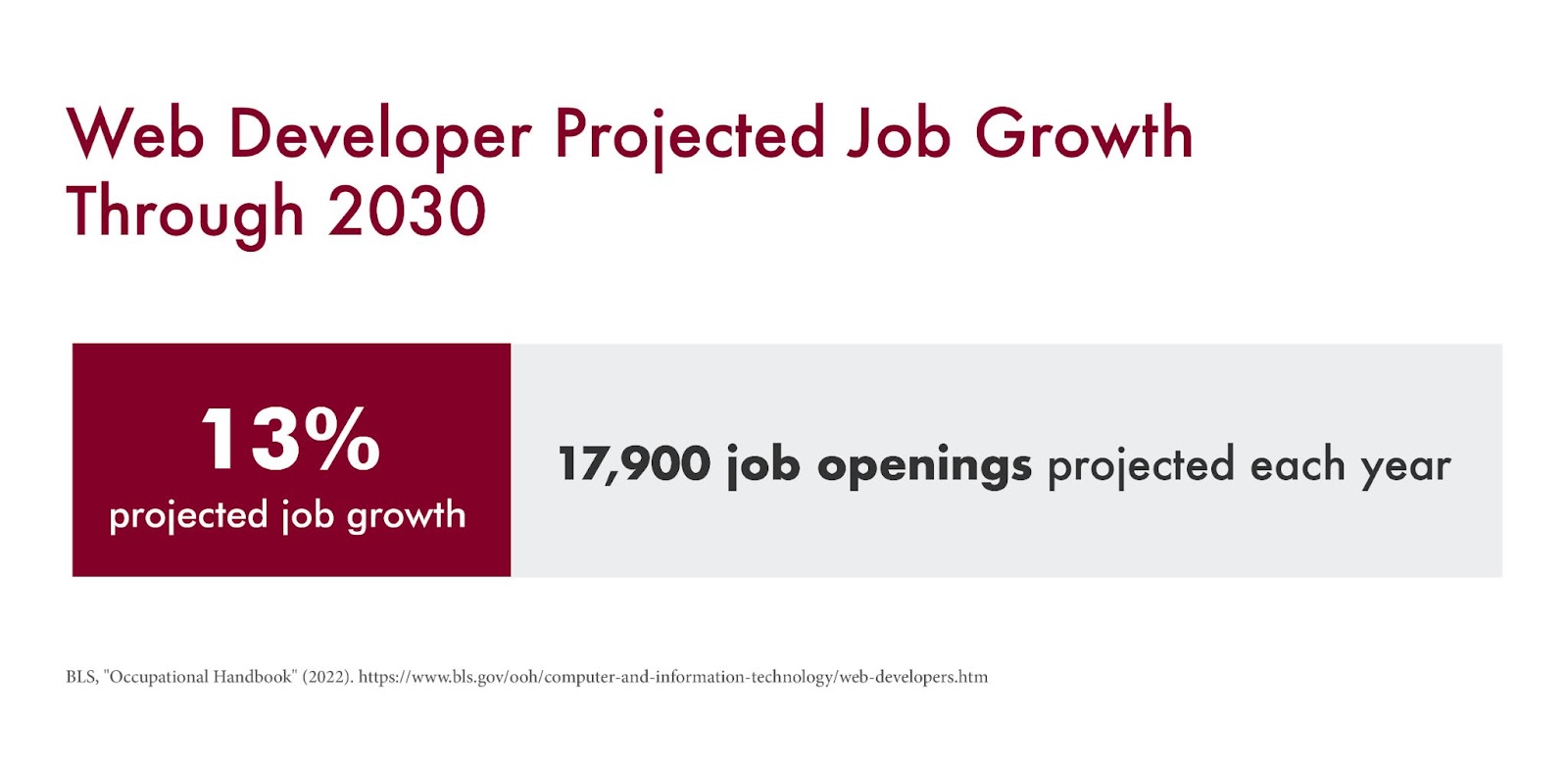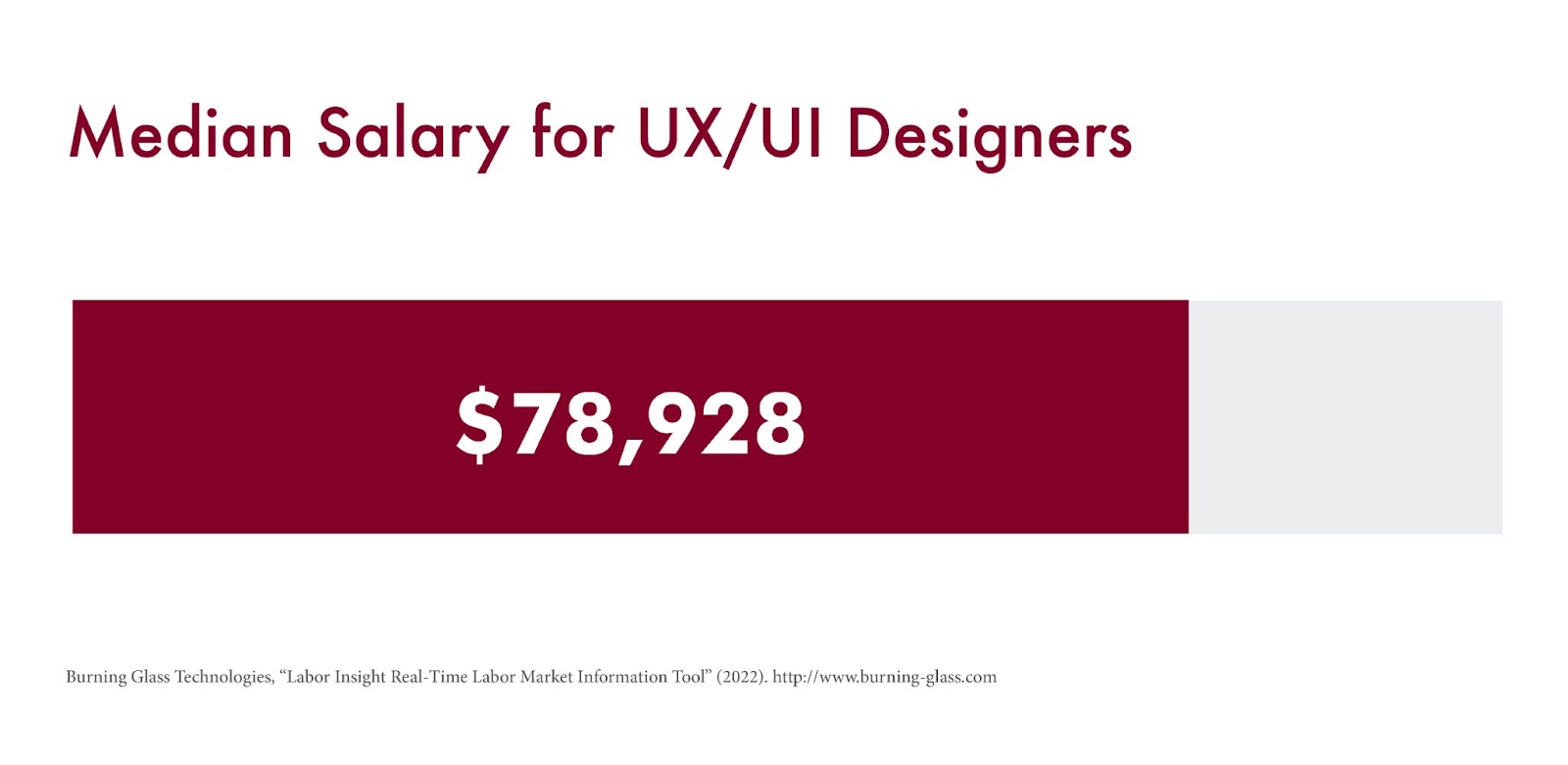The internet is now ubiquitous. It has penetrated every aspect of our existence, from working and shopping to traveling and dating. Still, despite its centrality to our lives, most people know very little about the industry that builds and maintains websites — namely, web design and development. Whether you’re fulfilling natural curiosity or contemplating a career change, this article will give you a rundown of the basics: we’ll explain the roles of web designer vs. web developer, discuss the skills needed to succeed in both fields, and investigate their career paths and salary ranges.
Web Designer vs. Web Developer: What’s the Difference?

What Does a Web Developer Do?
If you’re new to the industry, you might ask yourself: What does a web developer do? The simple answer is that web developers build the core structure of a website, implementing the vision of the web designer with whom they closely collaborate. They aim to create a smoothly functioning, error-free website and maintain it through regular updates and bug fixes. They accomplish this using programming languages, including JavaScript, HTML, CSS, and PHP. Given the immensity of this task, the web developer role typically focuses on one of three specialties: front end development, back end development, or full stack development.
A front end developer is someone who writes code for the part of the website accessed by the user, coding its layout, content, and interactive features. By contrast, a back end developer’s role is to program the behind-the-scenes components that support the front end — for example, coding for a website’s databases and servers where users do not directly interact. A full stack developer has experience with both front end and back end development, which allows them to oversee the entire process of developing and maintaining a website.
What Does a Web Designer Do?
If the web developer codes the website, you might be asking, What does a web designer do? A web designer is responsible for creating a website’s layout and determining how it will look and feel to users. A common analogy is that if the web developer is the builder, then the web designer is the architect — or the person who creates the blueprints and aesthetic philosophy behind the site.
The web design role breaks down into three specialties: user interface (UI), user experience (UX), and visual design. UI designers create the look and feel of a website or an application. Their job is to take a brand’s ethos and find a way to express it in a website’s design and layout. They ensure that the site’s interface components — buttons, menus, search fields, message boxes, etc. — are appealing and easy to use. On the other hand, UX designers are responsible for delighting users with the website, as well as gathering and incorporating their feedback to create an intuitive, easy-to-use experience. They conduct research using interviews, surveys, and evaluation scores; while also performing user testing and developing user profiles. Lastly, there are visual designers, whose role is a combination of UI and graphic design.
Interested in kickstarting a new career? Explore University of Denver Coding Boot Camp or University of Denver UX/UI Boot Camp and learn how to get started today.
Get Program Info
Web Design vs. Web Development
If you’re considering web design vs. web development in terms of a career shift, it’s a good idea to consider the skills necessary to succeed in both fields. Although both roles contribute to a website’s look, feel, and experience, each role demands different hard and soft skills. Typically, developers need to possess technical knowledge of programming languages, while designers should have a strong creative sensibility and a working knowledge of many design tools. A proper understanding of what’s required in each discipline will help you make a more informed decision about the career that’s right for you.
The first step in acquiring good web developer skills is learning the right programming languages. Of course, the requirements will change depending on whether you’re aiming to become a front end, back end, or full stack developer, and may vary by employer as well. Take some time to explore current job listings for web development roles and pay attention to the languages listed within the descriptions to learn more.
Front end developers write the code for the website’s design and layout. Therefore, they need to be proficient in HTML, CSS, and JavaScript. They should also have a solid understanding of responsive design principles which allow them to create websites with strong visual appeal across multiple devices, including smartphones, tablets, and laptops.
Conversely, back end developers code the servers and databases that power the website. They are familiar with a number of programming languages, including Python, PHP, Ruby, and SQL. These languages allow them to write code that handles servers and databases. Since full stack developers oversee both ends of development, they need to be familiar with the front and back end languages listed above, and be ready to take a leading role in creating the site’s development strategy.
Regardless of the path you choose, a strong analytical mindset and problem-solving skills are essential to long-term success. The website’s malfunctioning? It’s time for you to pore over the code and figure out what’s wrong.
Web designing certainly requires creative ability, but other skills will also be helpful if you want to pursue a successful career in the field. Determining the exact web design skills you’ll need depends on whether you want to become a UI, UX, or visual designer.
The UI designer is responsible for creating a beautiful website, meaning they will need to be knowledgeable about color theory, topography, and design principles. Think of the experience of interacting with your favorite, most aesthetically pleasing website — that effect is the work of great UI design. In terms of practical skills, UI designers should be familiar with industry standard tools, such as Sketch, Adobe XD, or Figma.
The UX designer role requires a slightly different skill set. While UX designers should be able to use design tools, they spend more of their time thinking about and collecting data about their product’s target users. UX designers need strong research skills and the ability to think creatively about responding to user needs. Lastly, visual designers should have a strong understanding of UI basics, as well as additional skills in graphic design, which will ensure they can create top-notch graphics and visuals for a given project.
One of the main benefits of a career in web development is versatility — a variety of industries will be right at your fingertips, including tech, finance, healthcare, and nonprofit. Maybe you’ll help Uber or DoorDash manage their flagship products, or perhaps you’ll build the first website for a small, family-owned farm.
When you begin your career, you’ll typically start as a junior web developer. From there, you’ll work your way up to becoming a senior web developer. Eventually, you may become a lead web developer and take on a more managerial role by directing the coding team and creating guidelines and strategies. You might also consider the freelance route, which will give you greater flexibility in terms of working hours and variety in project assignments.
With more businesses moving their functions online, it makes sense that web development careers will remain in demand. The data backs this up: the U.S. Bureau of Labor Statistics (BLS) Occupational Outlook Handbook projects that web developer jobs will grow by 13 percent by 2030. Additionally, web developer jobs can be very lucrative — the BLS lists the median salary for web developers at $77,200, with full stack developer jobs typically paying more than front end or back end web developer positions.

Given the diversity of industries needing beautiful website design, there are many options for fulfilling web design careers. Often, they can look very different from each other. While many individuals with web design training work as UX/UI designers, some pursue careers in other industries, becoming game designers or multimedia specialists.
Good UX/UI has the potential to enhance business outcomes. Working in an industry infamous for its bad UX — such as the public sector, finance, or healthcare — could be lucrative and rewarding. Perhaps you’ll work to design a public health outreach app that helps save lives, or create a site that clarifies insurance policy details.
The career path for a web designer loosely mirrors that of a web developer. Generally, you’ll start as a junior web designer, be promoted to senior designer after a few years of demonstrated proficiency, and then attain a position leading a design team. For those who prefer designing over leading a team, you can also remain a designer, receiving a title like “principal designer.” If working within a corporate structure isn’t appealing, you can become a freelance web designer and define your career independently.
You might be asking, just how lucrative are web designer jobs? Burning Glass Technologies estimates that the median salary for UX/UI designers is $78,928. (Source: Burning Glass Technologies: Labor Insight. 2020.) Certainly, it’s important to remember that salaries can vary widely by experience, location, and industry. Additionally, the web designer job outlook is strong. Burning Glass estimates that jobs for UX/UI designers will grow by 8.4 percent in the next ten years.

How to Become a Web Developer
If you’re an analytical person with a strong interest in programming, the question of how to become a web developer may have occurred to you. The paths to becoming a web developer are varied. Some developers seek formal training, while others are self-taught or reliant on self-guided courses. Pursuing a traditional computer science or web development degree is another pathway to break into the industry.
Another strong — and less time-consuming — option is to attend a coding boot camp, such as University of Denver Coding Boot Camp. This program, which can be completed in 12 weeks (full-time) or 24 weeks (part-time), gives you the web development skills needed to become a full stack developer. The curriculum covers languages like HTML, CSS, JavaScript, React.js, progressive web apps, database theory, and Git. In addition to receiving a theoretical grounding and the necessary practical skills, you’ll also work on projects and build applications that can be included as part of your professional portfolio when you apply for jobs.
Once you’ve completed your web developer education, it’s time to pour your energy into landing that first job. You’ll want to do some introspection at this stage, thinking about your short-term and long-term goals. What jobs and industries are right for you? Once you’ve answered these questions, you’ll be ready to start the application and interview process.
University of Denver Coding Boot Camp can also help at this stage by providing training that can help you ace the interview process, which can be daunting. You can receive reviews on your resume, get feedback on your portfolio samples, and conduct practice for technical interviews, which can be particularly tricky for new developers. You’ll also have access to a partner network of over 250 employers, opening up many employment opportunities post-completion.
How to Become a Web Designer
The question of how to become a web designer has a similar answer to that of a web developer. As with web development, those interested in web design can earn a degree in a relevant field at a university or take a self-guided course to learn the necessary web designer skills. However, for those interested in the benefits of training without the time commitment of pursuing a traditional degree, boot camps, such as University of Denver UX/UI Boot Camp, can provide an excellent web design education.
Designing beautiful websites that delight users takes knowledge and skill. Aspiring designers need to be familiar with UX/UI theory and proficient in using industry-standard design tools. Thankfully, University of Denver UX/UI Boot Camp provides you with a strong foundation in user-centric design research methods and design theory, along with practical skills like visual prototyping, wireframing, and web prototyping with HTML and CSS. This web designer education will equip you to become a successful web design professional and build your professional portfolio, which will be an essential component of the package you present to employers.
Given the varying options for a career in web design, it’s important to consider your career goals as you pursue your education. Make a list of companies and industries that interest you to help filter the field. Like the coding boot camp, University of Denver UX/UI Boot Camp provides excellent career-building services, including 1:1 career coaching, which can be especially helpful in narrowing down your career targets in a field with so many options. You will also receive detailed feedback on your resume and portfolio to help you tailor your pitch to employers. This package of services will set you up for success in your web design career.
Web Designer vs. Web Developer FAQs
Whether you’re interested in the field or just curious, you might be asking: What is a web designer? The answer is simple: a web designer is responsible for creating the aesthetic standards of a website and designing its layout and feel.
Just how much do web developers make? The BLS notes that the median salary for web developers is $77,200. However, salaries can vary widely based on experience, location, and industry.
Aspiring designers may ask themselves, how much do web designers make? Burning Glass Technologies puts the median salary of UX/UI designers at $78,928. As with web development, experience, location, and industry are crucial factors for determining salary — senior designers can earn well over the median.
The choice between web designer or web developer depends on your skills and interests. If you’re a technical, analytical person interested in programming, becoming a web developer is probably a good fit. In contrast, a creative individual interested in delighting users would be better positioned for web design.
A common question for those contemplating a career shift: Is being a web developer a good career? The answer is that if you’re a technically minded, analytical person interested in learning programming — then yes, becoming a web developer could be an excellent career choice.
Start Your Web Design or Development Journey Today
Though web design and web development are closely related professions, they have various unique characteristics separating them from one another. Those with a knack for user-facing creative design will likely prefer web design, while those favoring structural, core website work will probably gravitate to a web developer role. Regardless, both fields present a variety of promising career opportunities for aspiring tech professionals. University of Denver UX/UI Boot Camp offers a fast-paced, yet thorough learning environment in which to gain key UX/UI skills, while University of Denver Coding Boot Camp prepares learners for an exciting career in web development. No matter which route you choose, these boot camp programs can help you fully realize your abilities and confidently pursue a career in this rewarding field.

 Live Chat
Live Chat